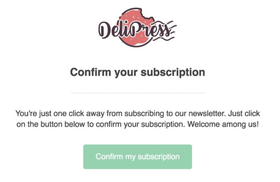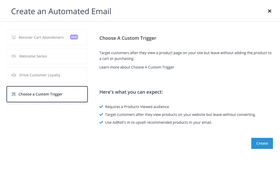Why AdRoll is Your Ideal Programmatic DSP
AdRoll helps you run full-funnel, multi-channel ad campaigns. Learn how our programmatic DSP enables better ad campaigns that convert customers.
Read More
Whether you’re an expert at setting up drip campaigns or have yet to send out your first welcome email, there’s one thing you should know: Your email list is your most valuable asset. But how does email list management work? Beyond developing irresistible email content, how else can you ensure your emails are read, your message is heard, and your return on investment (ROI) is at an all-time high?
Drumroll, please… Here are the six best practices for keeping your list clean and healthy, so you can keep your subscribers informed and engaged.
Email list management is precisely like what it sounds: maintaining, updating, and culling your email subscribers. This may include:
Removing duplicate, unsubscribed, or unengaged email contacts from your list
Tinkering with how you segment subscribers
Designing new ways to send more targeted emails
Email list management is a critical process to any email marketing effort — all too often, we see marketers overly preoccupied with how large their subscriber list is, in turn neglecting metrics like engagement, deliverability, and list attrition. If you’re holding onto inactive subscribers and treating them as though they are actively engaged, you’re misusing your resources.
Regularly cleaning up your email list can mean:
Sending more targeted and personalized emails
Understanding your audience and key segments better
Uncovering more reliable data
Achieving a higher inbox placement rate and sender reputation
Lowered costs
Through email list management, you can achieve a healthy email list — one with relevant, engaged subscribers who genuinely are happy to receive your emails. Attributes of a healthy list are:
Delivery rates that are 95% or higher
Frequent and regular new subscribers
Open rates around 15-25%
Low bounce rates no more than 3%
TL;DR: List quality > list quantity. Email list management is all about collecting data the right way and treating it properly — no more emails buried in spam folders!
While you may have already amassed a chunky email list, it’s worth the time and effort to make sure your opt-in forms are optimized — trust us, it’ll make managing your email list easier.
This entails:
Collecting user content properly. In recent years, lawmakers have enacted strict regulations that protect user privacy and first-party data. You’ll want to make sure that you’re GDPR– and CAN-spam-compliant, meaning everyone who is added to your email list genuinely had the intention of signing up.
Laying out exactly what subscribers can expect after signing up. Don’t make any false promises!
Requesting only the most essential personal information (name and email address) to streamline the sign-up process. You can gather details, like their birthdays and locations, at a later date.
Providing a link to a more detailed privacy policy page that lists exactly how you will store and process subscribers’ first-party data.
Adding Google’s reCAPTCHA to remove bot traffic and make sure your opt-in forms won’t be compromised.
Opt-in verification emails are essentially confirmation emails where subscribers have to click on a link to say, “Yes! I signed up for this ” These confirmed opt-ins allow you to filter out incorrect or invalid email addresses, signal to internet service providers (ISP) that you’re a valid sender, and boost your sender reputation.
Your opt-in verification email can be as simple as this.

New subscribers are the best subscribers — well, sort of. When shoppers sign up for your emails, that’s when their engagement and interest in your brand are at their max.
The best way to make the most out of their attention? By designing awesome welcome emails. (Or, even better, an entire onboarding email sequence.) Studies have found that welcome emails see incredibly high engagement rates — we’re talking over 85% open rates and 25% click-through rates, which will have a massive impact on your sender reputation.
In your welcome emails, consider:
Thanking shoppers for subscribing
Reiterating how you’ll treat their personal information (or link them to a page for more)
Setting their expectations on how often you’ll send them emails and what types of content you’ll be delivering
Fulfilling any promises you set on the sign-up form: free downloadable content, a discount code, or a button to unlock free shipping
Encouraging them to start exploring your product pages

AdRoll’s email marketing solution rolls everything related to automated emails into one handy platform: recovering cart abandoners, creating welcome series’, and driving customer loyalty.
Most major email marketing platforms offer tools that allow you to segment subscribers based on their demographics, attributes, location, and purchasing behavior. Segmenting your emails will help you design more personalized, targeted campaigns to increase relevance and engagement.
For instance, with tagging and segmenting, you might send a follow-up welcome message to a new subscriber who didn’t open the first one. For more on segmenting your emails, check out this post.
While some shoppers will take the initiative to hit the unsubscribe button themselves, most of the time, they’ll just ignore your emails or let their ISP move them to the spam folder once their inboxes clog up. It’s nothing personal — perhaps they’ve already purchased from your competitor, or maybe your products are no longer relevant to them. Either way, it’s unfortunate business. If a significant number of your subscribers aren’t engaging with your emails, ISPs will start sending all your emails straight to the junk or spam folder.
There are two ways for brands to tackle these unengaged subscribers who haven’t opened an email or clicked on links in several months:
Reactivate them by sending a “long time no see!” email with a compelling offer, paired with an introduction to your new products
Cull them after you’ve tried reactivating them with no success. Yes, this means removing them from your list — though this might seem like a drastic move with no return, it’ll do wonders for your budget and your deliverability. Try and focus on attracting new, more engaged shoppers.
While it’s a marketer’s dream to have happy shoppers who wait patiently for your next email, sometimes it’s just easier to let them unsubscribe — it’s definitely a better outcome than a customer reporting your email as spam or deleting it as unread.
That’s why we recommend an easy-to-access opt-out button in every email footer. Once on the landing page, provide options to subscribers — perhaps instead of opting out entirely, they can select exactly which types of content they want to receive and the frequency. Make it clear that unsubscribing isn’t the only option.
From better ROI to sending more relevant content, we can’t overstate the importance of email list management. With this guide, you’ll be on your way to better, more engaged subscribers who say, “Yes! I want this content. More, please!”
If you're working with AdRoll, we can help you use emails to their fullest: For Klaviyo customers, we can import Klaviyo lists and segments for coordinated ad targeting on display, Facebook, Instagram, TikTok, and Pinterest.
By importing metrics, we help customers analyze email performance alongside their AdRoll ads campaigns.
Our CCA dashboard can help you attribute across all of your marketing channels — ads, email, SMS, social, search, and more.
Last updated on January 31st, 2025.